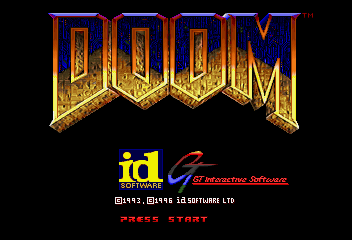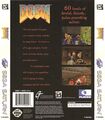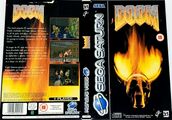Doom (Saturn)
From Sega Retro
- For the Sega 32X game, see Doom (32X).
| Doom | |||||||||||||||||||||||||||||||||||
|---|---|---|---|---|---|---|---|---|---|---|---|---|---|---|---|---|---|---|---|---|---|---|---|---|---|---|---|---|---|---|---|---|---|---|---|
| System(s): Sega Saturn | |||||||||||||||||||||||||||||||||||
| Publisher: GT Interactive (US/EU), Soft Bank (JP) | |||||||||||||||||||||||||||||||||||
| Developer: Rage Software | |||||||||||||||||||||||||||||||||||
| Original system(s): PC | |||||||||||||||||||||||||||||||||||
| Developer(s) of original games: id Software | |||||||||||||||||||||||||||||||||||
| Sound driver: SCSP/CD-DA (17 tracks) | |||||||||||||||||||||||||||||||||||
| Peripherals supported: Taisen Cable, Shuttle Mouse | |||||||||||||||||||||||||||||||||||
| Genre: Shoot-'em-Up | |||||||||||||||||||||||||||||||||||
| Number of players: 1-2 | |||||||||||||||||||||||||||||||||||
| |||||||||||||||||||||||||||||||||||
This short article is in need of work. You can help Sega Retro by adding to it.
Doom (ドゥーム) for the Sega Saturn is a set of first person shooters originally released for IBM PC compatibles running DOS in the early 1990s. Despite its name, the package consists of two games; The Ultimate Doom (a 1995 update of the 1993 game, Doom) and its sequel Doom II: Hell on Earth (1994), alongside a few extra levels seen in a previous PlayStation version of this package.
Contents
Versions
The Sega Saturn version of Doom derives from the 1995 PlayStation version, which itself derives from the Atari Jaguar port of the game (as do most home versions of the era). On the Jaguar, several levels from the original Doom were visibly altered for performance reasons - this, and several minor changes carry through to the Saturn.
For the PlayStation version, significant changes were made to create a more "atmospheric" tone, including a different lighting system and the omission of the original MIDI soundtrack. Intermission scenes were dropped and some secret levels (notably the Wolfenstein 3D-inspired levels of Doom II) were dropped and replaced with new maps. Enemy placement is at times very different, and Doom II's super shotgun can be used in The Ultimate Doom levels.
The Saturn port(s) builds on this, however it is thought to have been rushed, originally hitting North America in March 1997. A combination of poor frame rates, slower enemies (yet curiously player has faster firing speed) and numerous missing visual and audio effects led it to be panned by critics, as did a missing multiplayer mode, despite being advertised on the box (along with 60 levels, when in reality there are 59). Also notable is the use of Final Doom screenshots from a completely different release not included here. This is despite intervention from id Software and John Carmack himself[2].
Saturn programmer Jim Bagley had originally written an engine more suited to the Saturn, allowing VDP1 to handle the textured walls, floors and ceilings. Carmack reportedly veteoed the idea on behalf of id Software, as he did not like the affine texture warping inherent with 3D renderers which do not support texture perspective correction (like the VDP1). This means all rendering is handled by the dual SH-2 CPUs, save for the HUD and background texture which is updated separately by VDP2.
Performance is an issue for the Saturn version of the game, averaging around 12FPS during the original (optimised) Doom levels, but frequently dropping below 10FPS when dealing with the more complex geometry of Doom II. The firing rate of the weapons is thought to have been increased to compensate for this.
Early versions of the game were also reportedly compatible with the 3D Control Pad, but the feature was removed for unknown reasons[3].
Data from the PlayStation version of the game carries through the Saturn but is not used in-game, such as coloured lighting. True alpha transparency is also not present due to hardware restrictions, and audio is also incorrectly panned left when the stereo option is enabled.
When brought to Europe, support for the Taisen Cable was added (despite the accessory not being officially released in the region), and when released in Japan in July, the speed was increased to help it try and match the PlayStation version (though it is still slower in comparison). The Japanese version also adjusts the soundtrack to bring it more in-line with Sony's version, though performance is identical to the original North American release.
Production credits
- Programmers: John Carmack, John Romero, David Taylor, Michael John Cash
- Artist: Adrian Carmack, Kevin Cloud
- Level Designers: John Romero, Sandy Peterson, American McGee, Shawn Green
- Development Support: Shawn Green
- Biz: Jay Wilbur, Mike Wilson
- Biz Assistant: Donna Jackson
- Developed By: Rage Software
- Programming: Jim Bagley, Alan Webb
- Graphics: Simon Street, Ian Rickard
- Sound: Steve Lord, Kev Bruce
- Producer: John Heap
Magazine articles
- Main article: Doom (Saturn)/Magazine articles.
Promotional material
also published in:
- Sega Saturn Magazine (JP) #1997-02: "1997-02 (1997-01-31)" (1997-01-17)[4]
- Sega Saturn Magazine (JP) #1997-03: "1997-03 (1997-02-14)" (1997-01-31)[5]
- Sega Saturn Magazine (JP) #1997-04: "1997-04 (1997-02-21)" (1997-02-07)[6]
Artwork
Physical scans
| Sega Retro Average | ||||||||||||||||||||||||||||||||||||||||||||||||||||||||||||||||||||||||||||||||||||
|---|---|---|---|---|---|---|---|---|---|---|---|---|---|---|---|---|---|---|---|---|---|---|---|---|---|---|---|---|---|---|---|---|---|---|---|---|---|---|---|---|---|---|---|---|---|---|---|---|---|---|---|---|---|---|---|---|---|---|---|---|---|---|---|---|---|---|---|---|---|---|---|---|---|---|---|---|---|---|---|---|---|---|---|---|
|
| 58 | |
|---|---|
| Based on 16 reviews | |
Technical information
ROM dump status
| System | Hash | Size | Build Date | Source | Comments | |||||||||
|---|---|---|---|---|---|---|---|---|---|---|---|---|---|---|
| ✔ |
|
671,051,472 | CD-ROM(EU) | T-25406H-50 V1.004 | ||||||||||
| ✔ |
|
636,740,496 | 1997-03-25 | CD-ROM(JP) | T-18610G V1.300 | |||||||||
| ✔ |
|
671,053,824 | CD-ROM(US) | T-25405H V1.000 |
References
- ↑ 1.0 1.1 1.2 File:CVG UK 183.pdf, page 80 Cite error: Invalid
<ref>tag; name ":File:CVG UK 183.pdf_p80" defined multiple times with different content - ↑ File:MAXIMUM UK 07.pdf, page 124
- ↑ 3.0 3.1 3.2 File:MeanMachinesSega53UK.pdf, page 66 Cite error: Invalid
<ref>tag; name ":File:MeanMachinesSega53UK.pdf_p66" defined multiple times with different content - ↑ Sega Saturn Magazine, "1997-02 (1997-01-31)" (JP; 1997-01-17), page 32
- ↑ Sega Saturn Magazine, "1997-03 (1997-02-14)" (JP; 1997-01-31), page 33
- ↑ Sega Saturn Magazine, "1997-04 (1997-02-21)" (JP; 1997-02-07), page 14
- ↑ File:SSM_UK_16.pdf, page 72
- ↑ File:SSM_JP_19970718_1997-24.pdf, page 175
- ↑ 9.0 9.1 Saturn no Game wa Sekai Ichi~i~i~i!: Satamaga Dokusha Race Zen Kiroku, SoftBank Publishing, page 15 Cite error: Invalid
<ref>tag; name ":File:SnGwSISDRZK Book JP.pdf_p15" defined multiple times with different content - ↑ Gambler, "4/1997" (PL; 1997-xx-xx), page 1
- ↑ GameFan, "Volume 5, Issue 3: March 1997" (US; 1997-xx-xx), page 29
- ↑ GamePro, "April 1997" (US; 1997-xx-xx), page 91
- ↑ Game Informer, "December 1996" (US; 1996-1x-xx), page 72
- ↑ Hobby Consolas, "Diciembre 1996" (ES; 199x-xx-xx), page 112
- ↑ Player One, "Décembre 1996" (FR; 1996-xx-xx), page 65
- ↑ Saturn Fan, "1997 No. 17" (JP; 1997-08-29), page 84
- ↑ Secret Service, "Kwiecień 1997" (PL; 1997-xx-xx), page 64
- ↑ Sega Power, "January 1997" (UK; 1996-12-19), page 30
- ↑ Sega Saturn Magazine, "February 1997" (UK; 1997-01-16), page 72
- ↑ Sega Saturn Magazine, "1997-24 (1997-07-18)" (JP; 1997-07-04), page 175
- ↑ Super Juegos, "Febrero 1997" (ES; 1997-0x-xx), page 98
- ↑ Total Saturn, "Volume One Issue Six" (UK; 1997-02-28), page 32
NEC Retro has more information related to Doom II
|
- Pages with reference errors
- Shuttle Mouse-compatible games
- Taisen Cable-compatible games
- 1-2 player games
- JP Saturn games
- All JP games
- US Saturn games
- All US games
- EU Saturn games
- All EU games
- AU Saturn games
- All AU games
- BR Saturn games
- All BR games
- Saturn games
- 1997 Saturn games
- All 1997 games
- Saturn shoot-'em-up games
- All shoot-'em-up games
- Old content rating field
- All games
- Stubs
- Credits without source
- Credits without reference
- GalleryPrintAd file defined
- Old-style rating (cvg)
- Use magref
- Old-style rating (gamepro)
- Rating without source
- Old-style rating (gamesmaster)
- Rating without PDF source
- Old-style rating (mms)
- Old-style rating (segapower)
- Old-style rating (ssm)
- Old-style rating (ssmjp)
- Old-style rating (ssmjp r)
- Old-style rating (superjuegos)
- Update ratings template
- 7 old ratings
- Missing ROM hashes
- Old technical information














